Betta fish come in a range of vibrant colors and are excellent aquatic pets for beginners.
Setting up a betta tank may seem intimidating if you have never kept fish.
But with just ten simple steps, it is possible to set up a betta tank where your fish will thrive.
We have researched extensively to show you how to set up a betta fish tank and avoid common mistakes many make.
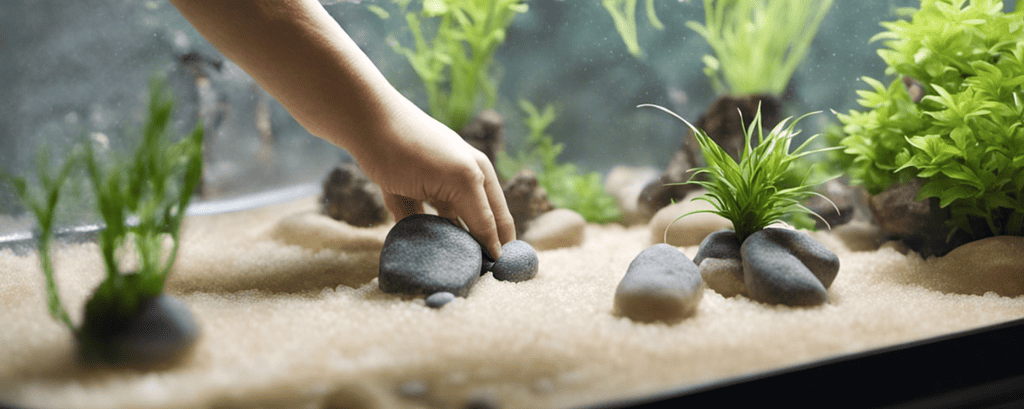
Table of Contents
Why a Proper Betta Fish Tank Setup Is Necessary
Taking the time to carefully set up your betta tank is the most important thing you will do for your fish.
Providing an ideal environment keeps your betta healthy.
Improper water parameters, low temperatures, and algae growth cause illnesses like ich or fin rot in your betta.
Tight spaces and sharp objects may lead to your betta getting stuck or suffering from abrasions or torn fins.
Placing your betta in the tank before completing a fishless cycle will also lead to serious issues in your fish.
While you may be excited to introduce your betta to its new home, it is better to wait.
Ensuring your betta has a healthy environment will save you from problems in the future.
#1 Gather the Best Betta Fish Setup Supplies
| Betta Fish Tank Supplies |
|---|
| Minimum of a 5 Gallon Horizontal Tank |
| Aquarium filter with Gph (Gallons per hour) x4 the size of your tank. |
| Aquarium heater with 3-5 watts per tank gallon. |
| Substrate – Small smooth gravel is an excellent choice. |
| Real plants (with appropriate substrate) or fake silk plants. |
| Decorations with smooth edges. |
| LED Light – 1 watt or less per tank gallon. |
Before setting up your new betta aquarium, you must gather all the necessary supplies.
Having all your supplies together saves time and makes setting up the tank easier.
Be wary of betta fish aquarium kits. Some of these kits may not have all the items needed for a proper betta tank setup.
Make a checklist of the items below to ensure you have everything you need for your betta tank.
Tank
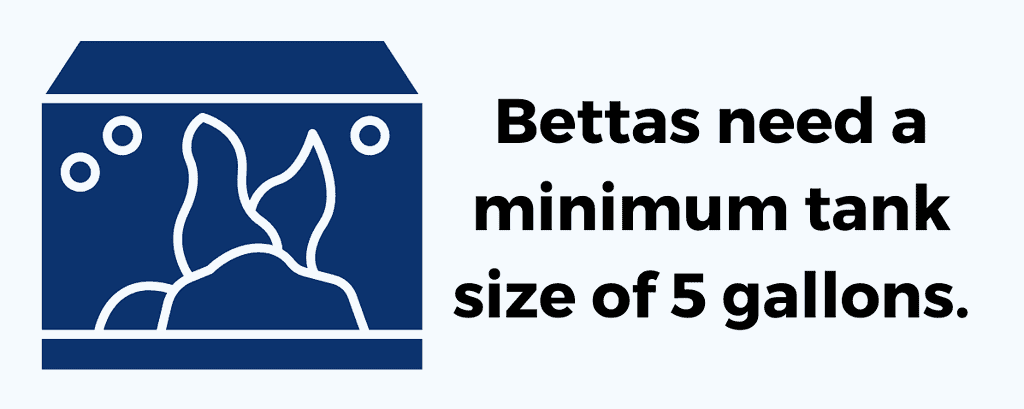
One of the biggest mistakes beginners make is choosing a small tank for their betta.
Avoid the tiny half-gallon betta fish bowls often advertised in pet stores.
Your betta needs a minimum tank size of 5 gallons, and a 10-gallon tank is even better if you have the space for it.
Even though betta fish are typically found in shallow freshwater, they need more room in captivity.
Providing your betta with plenty of space allows your fish to swim freely.
The tank must also have a lid to prevent your betta from jumping out.
Choose a horizontal tank instead of a vertical tank. Bettas prefer swimming from side to side and frequently go to the top of the tank to breathe air.
A vertical tank does not give your betta fish much room to swim around. The fish may also have difficulty swimming to the top for air.
Small betta fish bowls are also more challenging to keep clean. Ammonia and nitrites build up quickly in a small betta bowl setup, and you must constantly change the water.
You need at least a 5-gallon tank to establish a nitrogen cycle.
The nitrogen cycle is important because it helps break down waste and other bacteria to keep your betta healthy.
Filter

Another common mistake betta owners make is not putting a filter in their tank.
Bettas live in still waters in the wild, but a filter is necessary for an aquarium. The filter circulates oxygen in the tank and gets rid of harmful bacteria.
Be sure to purchase a gentle filter since bettas cannot swim in strong currents.
A filter with adjustable flow settings will allow you to create a slow current.
The filter must be rated to circulate all the water in your tank 4-6 times per hour. This rating on filters is known as the GPH, or gallons per hour.
Choose a filter with a GPH four times the size of your tank. For a 5-gallon tank, the filter must cycle at least 20 GPH.
Heater

Betta fish are native to a tropical climate, so a heater is needed for your tank.
A fully submersible heater with a thermostat keeps the water at optimal temperatures and is easy to monitor.
The wattage of your aquarium heater is directly related to the size of the tank.
An aquarium heater should provide 3-5 watts for every gallon of water.
For a 10-gallon tank, you need a 30-50 watt heater.
You may also use a couple of heaters in a larger tank, with one on each end. In a 10-gallon tank, two 20-watt heaters are ideal.
Whichever aquarium heater you choose, be sure it includes important safety features.
Always ensure your heater is rated to be fully submerged to avoid electrocuting yourself or your fish.
Look for an automatic shut-off feature, which turns the heater off if water levels are too low.
A protective casing is also essential for preventing your betta from getting too close to the heating elements.
Temperature readings on aquarium heaters are sometimes unreliable. Ensure your heater is working correctly by checking the temperatures with a separate thermometer.
Substrate or Gravel

The best substrate for the bottom of a betta tank is small, smooth aquarium gravel.
Sand may also be used, but it requires more maintenance and does not offer the same benefits as gravel.
Aquarium gravel helps anchor plants and grows beneficial bacteria to break down waste.
The gravel must be small and smooth to prevent injury to your betta fish.
While a bright neon substrate may appeal to you, it does not create a natural environment for your betta.
Unpainted, small river pebbles work best and are usually a mix of beige, gray, white, or black.
The neutral colors of aquarium gravel allow your brightly-colored betta to stand out in the tank.
To create even more contrast, use a dark substrate for a light fish and a light substrate for a dark fish.
Plants

Provide your betta with some hiding places by adding plants to your fish tank.
Real plants are best, as they naturally filter the water to keep it cleaner.
Some excellent, low-maintenance aquatic plants for your betta tank include:
- Anubias
- Java fern
- Marimo moss ball
- Water sprite
- Betta bulb
If you choose artificial plants for your betta fish tank, avoid ones made from plastic.
Plastic plants often have sharp edges, which will cause torn fins or abrasions on your betta.
Instead, use fake plants made from silk. Silk plants do not have sharp edges and are much safer for your betta.
Consider adding a betta leaf hammock near the top of the fish tank.
Betta leaf hammocks attach to the side of the tank with a suction cup.
The leaf hammock allows your betta to rest near the water’s surface.
Decorations

Bettas love exploring and interacting with their environment.
In addition to plants, adding caves, floating logs, or large rocks provides entertainment for your betta.
Caves and other hiding places help your betta feel secure, especially when it first moves into its larger home.
Avoid tank decorations made from metal, as they will rust and upset the water parameters in your tank.
You must also avoid decorations with sharp edges to prevent injuries to your betta.
Change the layout of your tank decorations when you clean the tank to keep your betta from getting bored.
Lighting

Betta fish need a day and night lighting schedule to regulate their sleeping habits.
Aquarium lighting is also necessary if you have live plants in your betta tank.
LED lights are a good choice because they do not give off heat.
Choose LED lights with a soft white or blue color. Harsh lighting will stress out your betta.
Adjustable aquarium lights allow you to control the intensity of light in the aquarium.
Light timers allow you to set them to turn on and off at specified times automatically. These timers are helpful if you have difficulty remembering to turn the lights off at the end of the day.
Too much light causes your betta to become stressed and agitated. Your fish may also stop eating.
The recommended wattage for LED lights is one watt or less per gallon of water in the tank.
When the lighting is too strong, it causes reflections in the fish tank. These reflections make your betta act aggressively.
If you notice aggressive behavior in your betta, use lights with a lower wattage.
Avoid placing your betta tank near a window in direct sunlight.
Sunlight causes algae bloom and temperature fluctuations in the fish tank.
#2 Install Your Betta Fish Filter
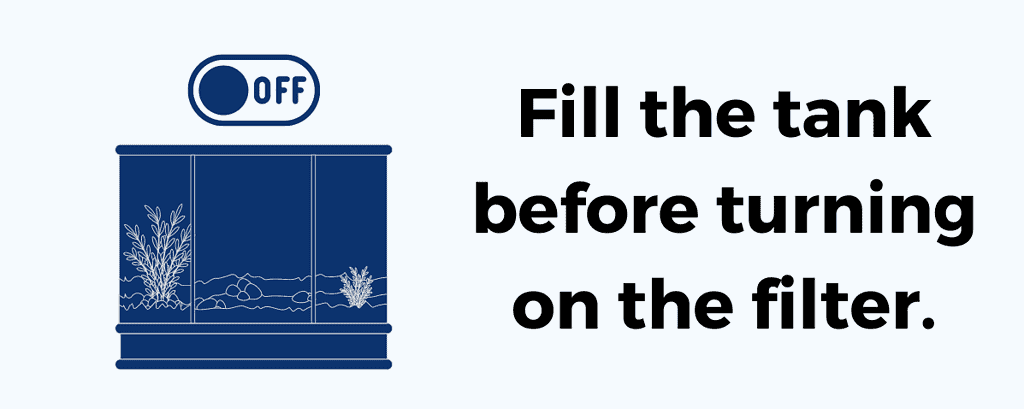
Once you have chosen where to place your tank, rinse it thoroughly with water.
You are now ready to install the filter on one end of the tank.
Filter installation varies, so consult the instruction manual for proper placement.
Or find a YouTube video for your particular filter.
Do not turn on your filter until you have filled the tank.
#3 Add Your Gravel or Substrate
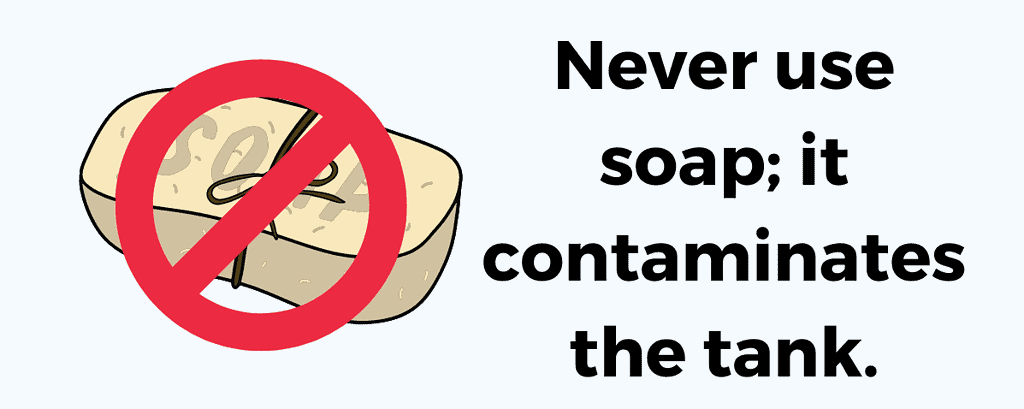
Rinse the gravel with cool water to remove dust. Never use soap because it is difficult to rinse away and will contaminate your tank.
Add at least 2” inches of aquarium gravel to the bottom of the tank if you are using real plants.
If you use silk plants, you only need a 1”-inch layer of gravel in the tank.
#4 Position Your Plants

Carefully bury the plant roots in the gravel to keep them anchored.
Place taller plants near the back of the tank and shorter ones in the front for better visibility of your betta.
Adding a few inches of water to the tank makes it easier to stabilize the plants and arrange them.
#5 Include The Tank Decorations
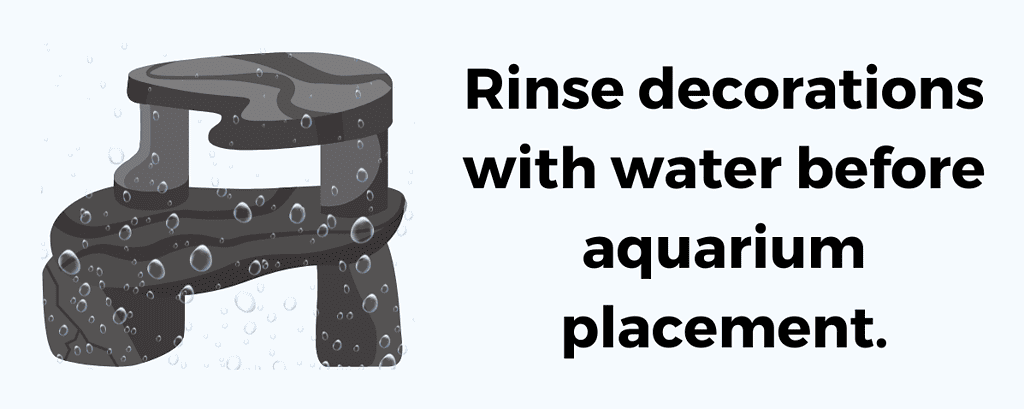
Rinse the tank decorations with water before placing them in the aquarium.
Never use soap or chemical cleaning products to clean anything you place in the tank.
Any leftover residues from cleaning products will contaminate the water.
Check the placement of your decorations. Avoid placing objects too close together or near the sides of the tank.
Your betta fish could get stuck in narrow cracks and crevices.
Ensure the decorations are firmly embedded in the gravel. This prevents the decorations from moving or tipping over.
#6 Fill Your Tank With Water

Once you are happy with the placement of plants and decorations, it is time to fill your tank with water.
Tap water is acceptable if you add a neutralizer to remove the chlorine.
Never use distilled water to fill your betta tank. Distilled water lacks vital minerals your betta needs.
Pour the water over a small plate or plastic container lid. Pouring the water directly onto the gravel will cause it to shift.
Check for any leaks as you fill the tank.
Leave at least 1” inch of space at the top of the tank.
Betta fish have an organ called a labyrinth, which allows them to breathe air.
Even if the water has plenty of oxygen, the betta still needs to come to the surface to breathe air every once in a while.
Bettas use the labyrinth organ to create bubble nests on the water’s surface. These bubble nests are part of the betta’s mating process.
Seeing bubble nests in your tank lets you know your betta is comfortable in its environment.
Use a test kit to check the water parameters in your betta tank.
The ideal water parameters for a betta fish tank are:
- Temperature: 78-80° degrees Fahrenheit (27° C)
- pH: 6.5-7
- Ammonia: 0 ppm (parts per million)
- Nitrites: 0 ppm
- Nitrates: < 40 ppm
Do not worry if your water parameters are not exact at this stage.
You will be able to adjust the water parameters during the fishless cycle.
This is also an excellent time to check for sharp edges on your tank decorations.
Use a small net and move it over any logs, caves, or rocks.
If the net gets snagged on an item, it is too sharp for your betta fish.
#7 Activate Your Filter
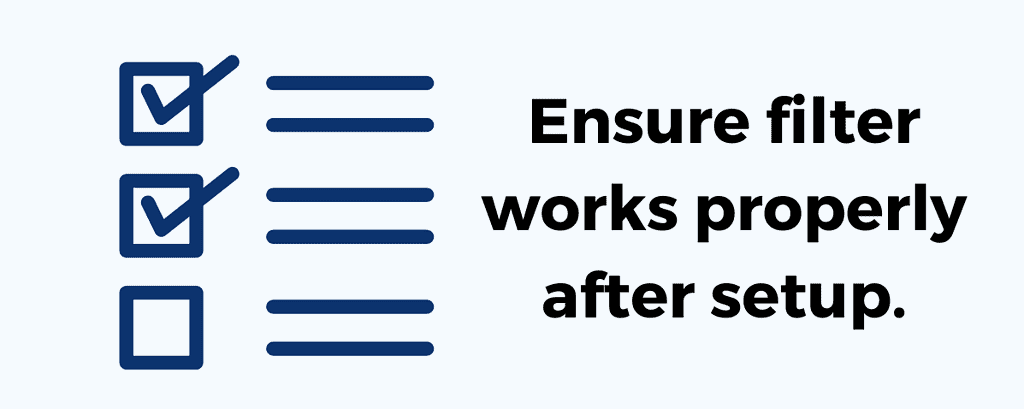
After the tank is filled with water, it is time to turn on the filter.
Ensure the filter works properly and adjust the flow if it is too strong.
If the water flow seems too strong on the lowest setting, add a plant near the filter to slow the current.
You may also place a small sponge on the filter outlet to decrease the water flow.
#8 Add Your Heater

Place the heater close to your filter. This allows warm water to circulate to the entire tank.
The optimal betta fish water temperature ranges from 78-80° degrees Fahrenheit (27° C).
If temperatures in your betta tank drop too low, your fish will show symptoms of cold shock, including:
- Lethargy
- Staying on the bottom of the tank
- Coma
- Frequent illness
When temperatures in the tank are too high, your betta will have symptoms such as:
- Rapid breathing
- Staying at the surface
- Erratic swimming
Your goal is to maintain a steady temperature throughout the betta tank.
Temperature fluctuations are dangerous for your betta and lead to illness.
Use a separate thermometer to ensure your heater is keeping the correct temperature. Measure several areas of the tank for accuracy.
#9 Run a Fishless Cycle

With everything in place, it is time to run a fishless cycle.
If you used tap water to fill the tank, you must add a dechlorinator.
The dechlorinator neutralizes chlorine, which is deadly for your betta.
You will not be able to complete a nitrogen cycle if there is chlorine in the water.
Follow the directions on the bottle to add the correct amount of dechlorinator to the water.
The nitrogen cycle is vital to the health of your betta fish.
During the nitrogen cycle, beneficial bacteria build up in the tank and filter.
These helpful bacteria break ammonia down to nitrite, which is converted to nitrate. Ammonia and nitrite are toxic, but nitrate is not in small amounts.
The nitrogen cycle takes around 4-8 weeks to complete.
Have patience, and do not attempt to rush this step. Incorrect water parameters are deadly for bettas.
You will know the nitrogen cycle is complete by testing the water.
A healthy tank has zero ammonia, nitrite, and less than 40 ppm of nitrate.
#10 Acclimatizing and Introducing Your Betta Fish to its New Tank

Your tank is completely set up, and you are ready to bring your betta fish home.
Inspect your betta fish to ensure it is healthy.
Look for warning signs of an unhealthy betta fish, such as:
- Fuzz or white dots on the scales
- Ragged fins or scales
- Eye deformities
- Lack of movement
Signs of a healthy betta fish include:
- Active swimming
- Brightly-colored body
- Undamaged fins and scales
- Flaring at you or other bettas
When you bring home your betta, you must acclimate the fish to its new environment.
Float the container with your betta fish on top of the tank. This allows the water in the container to reach the same temperature as the tank.
Dumping your betta directly into the tank may cause temperature shock.
Once the water in the container has reached the correct temperature, use a small net to scoop up your betta.
You do not want the water in the container to mix with the cycled water in your tank.
Gently place the net into the tank and allow your betta to swim out on its own.
Your betta may initially be shy and will likely hide until it adjusts to the new surroundings.
Maintain your tank by performing partial water changes to lower the nitrate levels.
Use a gravel vacuum to clean the substrate and siphon the water. Remember to treat the new water with a dechlorinator before adding it to the tank.
Remove algae from the glass with a clean toothbrush or aquarium scrubber.
Final Thoughts on Setting Up a Betta Fish Tank
Keeping your new betta healthy starts with a proper tank setup.
Setting up a betta fish tank is not difficult, but it does take a bit of patience.
Creating a safe environment for your betta ensures your fish stays healthy and happy.
By following our helpful guide, you will be able to avoid many of the common mistakes beginner betta owners make.


